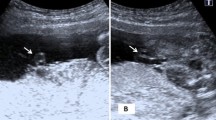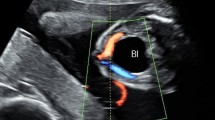Summary
In a case control study we assessed 47 fetuses with absent or reverse end-diastolic flow velocities (AREDFV) of the umbilical artery with respect to the mode of delivery, fetal acidosis, and abnormal neurological evaluations at the time of discharge from the department of pediatrics. We also studied a control group which was matched for gestational age and had normal umbilical artery flow velocity waveforms. Fetuses with AREDFV were delivered almost exclusively by cesarean section which was usually done for fetal distress. The number of fetuses with abnormal neurological signs was significantly increased compared to the control group. Fetuses with AREDFV showed an increased incidence of fetal acidosis. Forty per cent of these fetuses were delivered within one day of the first abnormal flow measurement; Sixty per cent were observed clinically for up to four weeks before delivery.
Similar content being viewed by others
References
Altman DG (1991) Practical statistics for medical research, 1st edn. Chapman and Hall, London, pp 258–259
Brar HS, Platt LD (1988) Reverse end-diastolic flow velocity of umbilical artery velocimetry in highrisk pregnancies: An ominous finding with adverse pregnancy outcome. Am J Obstet Gynecol 159:449–561
Chambers SE, Hoskins PR, Haddad NG, Johnstone FD, McDicken WN, Muir BB (1989) A comparison of fetal abdominal circumference measurements and Doppler ultrasound in the prediction of small-for-dates babies and fetal compromise. Br J Obstet Gynaecol 96:803–808
Dempster J, Mires GJ, Patel N, Taylor DJ (1989) Umbilical artery velocity waveforms: poor association with small-for-gestational-age babies. Br J Obstet Gynaecol 96:692–696
Fendel H, Fettweis P, Billet P, Werdin R, Sohn C, Giani G, Freiberg C (1987) Doppleruntersuchungen des arteriellen utero-feto-plazentaren Blutflusses vor und während der Geburt. Z Geburtshilfe Perinatol 191:121–129
Fischer WM (1981) Kardiotokographie. Thieme, Stuttgart, pp 294–302
Giles WB, Trudinger BJ, Baird PJ (1985) Fetal umbilical artery flow velocity waveforms and placental resistance: pathological correlation. Br J Obstet Gynaecol 92:31–38
Griffin D, Cohen-Overbeek T, Campbell S (1983) Fetal and uteroplacental blood flow. Clin Obstet Gynecol 10:565–602
Hitschold T, Weiss E, Beck T, Müntefering H, Berle P (1990) Beeinflußt die Vaskularisation der Placenta fetalis die enddiastolischen Blutflußgeschwindigkeiten in den Nabelarterien? Geburtshilfe Frauenheilkd 50:623–627
Hohmann M, Künzel W, Kirschbaum M (1986) Wehenbelastungstest mit Oxytocin-Nasenspray zur Diagnose der fetalen Hypoxämie. Z Geburtshilfe Perinatol 190:210–214
McCowan LM, Mullen BM, Ritchie K (1987) Umbilical artery flow velocity waveforms and the placental vascular bed. Am J Obstet Gynecol 157:900–902
Reuwer PJHM, Sijmons EA, Rietman GW, van Tiel MWM, Bruinse HW (1987) Intrauterine growth retardation: Prediction of perinatal distress by Doppler ultrasound. Lancet I:415–418
Rochelson B, Schulman H, Farmakides G, et al. (1987) The significance of absent end-diastolic velocity in umbilical artery waveforms. Am J Obstet Gynecol 156:1213–1218
Roemer VM, Buehler K, Kieback DG (1990) Gestationszeit und Geburtsgewicht, 1. Mitteilung: Intrauterine Wachstumskurven. Z Geburtshilfe Perinatol 194:241–253
Schulman H, Winter D, Farmakides G, et al. (1989) Pregnancy surveillance with Doppler velocimetry of uterine and umbilical arteries. Am J Obstet Gynecol 160:192–196
Trudinger BJ, Giles WB, Cook CM (1985) Uteroplacental blood flow velocity-time waveforms in normal and complicated pregnancy. Br J Obstet Gynaecol 92:39–45.
Weiss E, Hitschold T, Berle P (1990) Akute und chronische Reduktion diastolischer Blutflußgeschwindigkeiten der fetalen Nabelarterien: Eine dopplersonographische Untersuchung. Geburtshilfe Frauenheilk 50:694–700
Weiss E, Hitschold T, Berle P (1991) Umbilical artery blood flow velocity waveforms during variable decelerations of fetal heart rate. Am J Obstet Gynecol 164:534–540
Author information
Authors and Affiliations
Additional information
The investigations were supported by the Verein zur Forschung und Fortbildung von Nachwuchskräften in Gynäkologie und Geburtshilfe, Wiesbaden
Rights and permissions
About this article
Cite this article
Weiss, E., Ulrich, S. & Berle, P. Condition at birth of infants with previously absent or reverse umbilical artery end-diastolic flow velocities. Arch Gynecol Obstet 252, 37–43 (1992). https://doi.org/10.1007/BF02389605
Received:
Accepted:
Issue Date:
DOI: https://doi.org/10.1007/BF02389605




